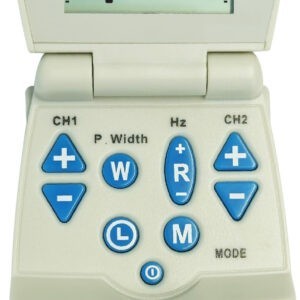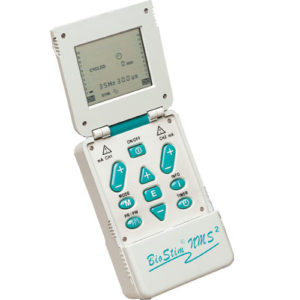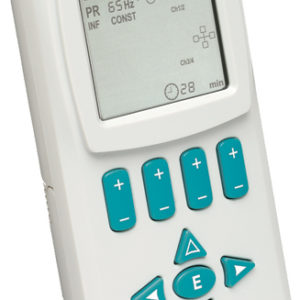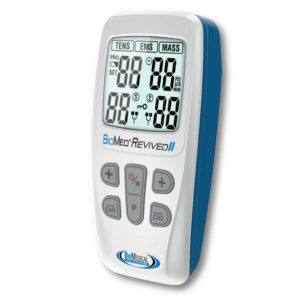Understanding
NMS (Neuromuscular Stimulation) aka: NMES / EMS
NeuroMuscular Stimulation is a type of electro-stimulation unit known by many names in the industry such as e-stim, N.M.E.S., NMS, electrical muscle stimulator, etc. all of these words correspond to a unit providing electro stimulation used for the prevention or retardation of muscle spasm; muscle reeducation; maintaining and increasing the range of motion; increasing local blood circulation or as an immediate post-surgical stimulation of calf muscles to prevent venous thrombosis.
The NeuroMuscular Stimulator (e-stim, N.M.E.S., NMS,) is a form of electro-stimulation that concerns both nerves and muscles. Therefore the stimulators in this electro-stimulation category are used to stimulate the underlying nerves to elicit a muscle contraction.
BioMedical Life Systems, Inc. offers several types of NeuroMuscular Stimulators (N.M.E.S). The EMS 2000 (Electrical Muscle Stimulator) is an analog unit (dials are used to adjust the settings). The unit has 2 channels allowing up to 4 electrodes to be utilized per treatment. This portable unit provides accurate electro stimulation and has a belt clip allowing the patient to wear the unit at home or in the office.
The BioStim® NMS2 is a digital NeuroMuscular Stimulator. The digital technology of this N.M.E.S unit utilizes micro processing to provide accurate electro stimulation. The digital interface allows great flexibility when setting the parameters. It is one of the most powerful portable e-stim units on the market and with 120mA amplitude and a 400 micro second pulse width, this N.M.E.S. unit is ideal for muscle rehabilitation. The BioStim® NMS2 has two waveforms, symmetrical biphasic and asymmetrical biphasic allowing the clinician to choose the type of electro-stimulation they prefer to provide the greatest therapeutic benefit. A timer feature allows for timed treatment and the 8 preset therapies and 3 programmable modes make the unit easy to use without compromising flexibility. The patient lock/compliance monitoring system tracks patient usage while ensuring the settings stay in place as the clinician has prescribed.
The QuadStar II® is in an elite class of digital electrical muscle stimulators. The unit has 4 channels allowing up to 8 electrodes to be utilized per treatment. The QuadStar II® is ideal for the patient who requires muscle rehabilitation in large areas or multiple sites. The unit incorporates a large digital display, 9 preset therapies, three waveforms, asymmetrical biphasic, symmetrical biphasic and pulsed sine, timer, patient lock/compliance system and wall adaptor. This e-stim is ideal for clinic or home use; the unit can stand on a table, or be worn on a belt. The QuadStar II® e-stim can be used for pain relief and muscle rehabilitation. The QuadStar II® is truly in a class of it’s own.
 |
||||
Pulse Rate |
On Ramp |
On Time |
Off Time |
Stimulation |
| 20-60 pps | 4 Sec. | 10 Sec. | 10 Sec. | Reciprocating |
| Negative Electrode | Over the proximal third of the dorsal surface of the patient’s forearm. |
|||
| Positive Electrode | On dorsal surface just proximal to the wrist | |||
 |
||||
Pulse Rate |
On Ramp |
On Time |
Off Time |
Stimulation |
| 20-60 pps | 4 Sec. | 10 Sec. | 10 Sec. | Reciprocating |
| Negative Electrode | Over the flexor tendors distally on the upper third of the volar forearm. | |||
| Positive Electrode | Over the flexor tendors distally on the volar forearm. | |||
 |
||||
Pulse Rate |
On Ramp |
On Time |
Off Time |
Stimulation |
| 20-60 pps | 4 Sec. | 10 Sec. | 10 Sec. | Cycled |
| Negative Electrode | Placed on the proximal medial aspect of the volar forearm. | |||
| Positive Electrode | On the volar distal forearm approximately 2″ (5 cm) above proximal wrist crease. | |||
 |
||||
Pulse Rate |
On Ramp |
On Time |
Off Time |
Stimulation |
| 20-60 pps | 4 Sec. | 10 Sec. | 10 Sec. | Cycled |
| Negative Electrode | Placed over the posterior deltoid on the proximal third of the upper arm | |||
| Positive Electrode | Is placed in the supraspinous fossa just above the spine of the scapula. | |||
 |
||||
Pulse Rate |
On Ramp |
On Time |
Off Time |
Stimulation |
| 20 pps | 4 Sec. | 10 Sec. | 15 Sec. | Cycled |
| Negative Electrode | Placed over the posterior deltoid on the proximal third of the upper arm | |||
| Positive Electrode | Is placed in the supraspinous fossa just above the spine of the scapula. | |||
 |
||||
Pulse Rate |
On Ramp |
On Time |
Off Time |
Stimulation |
| 30-35 pps | 2 Sec. | 15 Sec. | 30 Sec. | Cycled |
| Negative Electrode | Double-plugged into electrode over the motor point of the infraspinatus. | |||
| Positive Electrode | Electrode from channel 1 is placed over the motor point of the supraspinatus. The electrode from channel 2 is placed over the motor point of the teres minor. | |||
 |
||||
Pulse Rate |
On Ramp |
On Time |
Off Time |
Stimulation |
| 20-30 pps | 4 Sec. | 25 Sec. | 10 Sec. | Cycled |
| Negative Electrode | Placed bilaterally at L2-L4 levels over the erector spinae muscle bulk. | |||
| Positive Electrode | Placed bilaterally at L2-L4 levels over the erector spinae muscle bulk. | |||
 |
||||
Pulse Rate |
On Ramp |
On Time |
Off Time |
Stimulation |
| 30 pps | 2 Sec. | 15 Sec. | 20 Sec. | Cycled |
| Negative Electrode | Proximal and lateral on the lower leg over the muscle bellies of the anterior tibialis and peroneal muscle groups. | |||
| Positive Electrode | Is placed distal on the lower leg and over the peroneal tendons. | |||
 |
||||
Pulse Rate |
On Ramp |
On Time |
Off Time |
Stimulation |
| 25-35 pps | 2 Sec. | 10 Sec. | 20 Sec. | Cycled |
| Negative Electrode | Proximal and lateral on the lower leg over the muscle bellies of the anterior tibialis and peroneal muscle groups. | |||
| Positive Electrode | Is placed distal on the lower leg and over the peroneal tendons. | |||
 |
||||
Pulse Rate |
On Ramp |
On Time |
Off Time |
Stimulation |
| 25-35 pps | 2 Sec. | 20 Sec. | 20 Sec. | Cycled |
| Negative Electrode | Placed on the midline so that both heads of the gastrocnemius as well as the soleus are stimulated. | |||
| Positive Electrode | Is placed in the midline well above the Achilles Tendon. | |||
 |
||||
Pulse Rate |
On Ramp |
On Time |
Off Time |
Stimulation |
| 25-35 pps | 2 Sec. | 20 Sec. | 20 Sec. | Cycled |
| Negative Electrode | Place relativly low and laterally on the muscle bulk of the ham strings, keeping away from the adductors. | |||
| Positive Electrode | Is placed distal to the active electrode or 2″ (5 cm) proximal to the popliteal crease. | |||
 |
||||
Pulse Rate |
On Ramp |
On Time |
Off Time |
Stimulation |
| 25-35 pps | 2 Sec. | 20 Sec. | 20 Sec. | Cycled |
| Negative Electrode | Place over the lateral muscle bulk of the thigh, just distal to the greater trochanter. | |||
| Positive Electrode | Is placed intermediately superior to the patella. | |||
 |
||||
Pulse Rate |
On Ramp |
On Time |
Off Time |
Stimulation |
| 30-50 pps | 2 Sec. | 15 Sec. | 20 Sec. | Cycled |
| Negative Electrode | Proximal 1/3 of the medial thigh. | |||
| Positive Electrode | Is placed over the distal 1/3 of the thigh. | |||
 |
||||
Pulse Rate |
On Ramp |
On Time |
Off Time |
Stimulation |
| 30-50 pps | 2 Sec. | 15 Sec. | 20 Sec. | Cycled |
| Negative Electrode | Is placed over the motor point of the vastus medialis oblique. | |||
| Positive Electrode | Is placed over the anterior tibialis and toe extensor musculature. | |||
- What is NeuroMuscular Stimulation
-
NeuroMuscular Stimulation is a type of electro-stimulation unit known by many names in the industry such as e-stim, N.M.E.S., NMS, electrical muscle stimulator, etc. all of these words correspond to a unit providing electro stimulation used for the prevention or retardation of muscle spasm; muscle reeducation; maintaining and increasing the range of motion; increasing local blood circulation or as an immediate post-surgical stimulation of calf muscles to prevent venous thrombosis.
The NeuroMuscular Stimulator (e-stim, N.M.E.S., NMS,) is a form of electro-stimulation that concerns both nerves and muscles. Therefore the stimulators in this electro-stimulation category are used to stimulate the underlying nerves to elicit a muscle contraction.
BioMedical Life Systems, Inc. offers several types of NeuroMuscular Stimulators (N.M.E.S). The EMS 2000 (Electrical Muscle Stimulator) is an analog unit (dials are used to adjust the settings). The unit has 2 channels allowing up to 4 electrodes to be utilized per treatment. This portable unit provides accurate electro stimulation and has a belt clip allowing the patient to wear the unit at home or in the office.
The BioStim® NMS2 is a digital NeuroMuscular Stimulator. The digital technology of this N.M.E.S unit utilizes micro processing to provide accurate electro stimulation. The digital interface allows great flexibility when setting the parameters. It is one of the most powerful portable e-stim units on the market and with 120mA amplitude and a 400 micro second pulse width, this N.M.E.S. unit is ideal for muscle rehabilitation. The BioStim® NMS2 has two waveforms, symmetrical biphasic and asymmetrical biphasic allowing the clinician to choose the type of electro-stimulation they prefer to provide the greatest therapeutic benefit. A timer feature allows for timed treatment and the 8 preset therapies and 3 programmable modes make the unit easy to use without compromising flexibility. The patient lock/compliance monitoring system tracks patient usage while ensuring the settings stay in place as the clinician has prescribed.
The QuadStar II® is in an elite class of digital electrical muscle stimulators. The unit has 4 channels allowing up to 8 electrodes to be utilized per treatment. The QuadStar II® is ideal for the patient who requires muscle rehabilitation in large areas or multiple sites. The unit incorporates a large digital display, 9 preset therapies, three waveforms, asymmetrical biphasic, symmetrical biphasic and pulsed sine, timer, patient lock/compliance system and wall adaptor. This e-stim is ideal for clinic or home use; the unit can stand on a table, or be worn on a belt. The QuadStar II® e-stim can be used for pain relief and muscle rehabilitation. The QuadStar II® is truly in a class of it’s own.
- NMS Protocols
-

Pulse Rate
On Ramp
On Time
Off Time
Stimulation
20-60 pps 4 Sec. 10 Sec. 10 Sec. Reciprocating Negative Electrode Over the proximal third of the dorsal surface
of the patient’s forearm.Positive Electrode On dorsal surface just proximal to the wrist 
Pulse Rate
On Ramp
On Time
Off Time
Stimulation
20-60 pps 4 Sec. 10 Sec. 10 Sec. Reciprocating Negative Electrode Over the flexor tendors distally on the upper third of the volar forearm. Positive Electrode Over the flexor tendors distally on the volar forearm. 
Pulse Rate
On Ramp
On Time
Off Time
Stimulation
20-60 pps 4 Sec. 10 Sec. 10 Sec. Cycled Negative Electrode Placed on the proximal medial aspect of the volar forearm. Positive Electrode On the volar distal forearm approximately 2″ (5 cm) above proximal wrist crease. 
Pulse Rate
On Ramp
On Time
Off Time
Stimulation
20-60 pps 4 Sec. 10 Sec. 10 Sec. Cycled Negative Electrode Placed over the posterior deltoid on the proximal third of the upper arm Positive Electrode Is placed in the supraspinous fossa just above the spine of the scapula. 
Pulse Rate
On Ramp
On Time
Off Time
Stimulation
20 pps 4 Sec. 10 Sec. 15 Sec. Cycled Negative Electrode Placed over the posterior deltoid on the proximal third of the upper arm Positive Electrode Is placed in the supraspinous fossa just above the spine of the scapula. 
Pulse Rate
On Ramp
On Time
Off Time
Stimulation
30-35 pps 2 Sec. 15 Sec. 30 Sec. Cycled Negative Electrode Double-plugged into electrode over the motor point of the infraspinatus. Positive Electrode Electrode from channel 1 is placed over the motor point of the supraspinatus. The electrode from channel 2 is placed over the motor point of the teres minor. 
Pulse Rate
On Ramp
On Time
Off Time
Stimulation
20-30 pps 4 Sec. 25 Sec. 10 Sec. Cycled Negative Electrode Placed bilaterally at L2-L4 levels over the erector spinae muscle bulk. Positive Electrode Placed bilaterally at L2-L4 levels over the erector spinae muscle bulk. 
Pulse Rate
On Ramp
On Time
Off Time
Stimulation
30 pps 2 Sec. 15 Sec. 20 Sec. Cycled Negative Electrode Proximal and lateral on the lower leg over the muscle bellies of the anterior tibialis and peroneal muscle groups. Positive Electrode Is placed distal on the lower leg and over the peroneal tendons. 
Pulse Rate
On Ramp
On Time
Off Time
Stimulation
25-35 pps 2 Sec. 10 Sec. 20 Sec. Cycled Negative Electrode Proximal and lateral on the lower leg over the muscle bellies of the anterior tibialis and peroneal muscle groups. Positive Electrode Is placed distal on the lower leg and over the peroneal tendons. 
Pulse Rate
On Ramp
On Time
Off Time
Stimulation
25-35 pps 2 Sec. 20 Sec. 20 Sec. Cycled Negative Electrode Placed on the midline so that both heads of the gastrocnemius as well as the soleus are stimulated. Positive Electrode Is placed in the midline well above the Achilles Tendon. 
Pulse Rate
On Ramp
On Time
Off Time
Stimulation
25-35 pps 2 Sec. 20 Sec. 20 Sec. Cycled Negative Electrode Place relativly low and laterally on the muscle bulk of the ham strings, keeping away from the adductors. Positive Electrode Is placed distal to the active electrode or 2″ (5 cm) proximal to the popliteal crease. 
Pulse Rate
On Ramp
On Time
Off Time
Stimulation
25-35 pps 2 Sec. 20 Sec. 20 Sec. Cycled Negative Electrode Place over the lateral muscle bulk of the thigh, just distal to the greater trochanter. Positive Electrode Is placed intermediately superior to the patella. 
Pulse Rate
On Ramp
On Time
Off Time
Stimulation
30-50 pps 2 Sec. 15 Sec. 20 Sec. Cycled Negative Electrode Proximal 1/3 of the medial thigh. Positive Electrode Is placed over the distal 1/3 of the thigh. 
Pulse Rate
On Ramp
On Time
Off Time
Stimulation
30-50 pps 2 Sec. 15 Sec. 20 Sec. Cycled Negative Electrode Is placed over the motor point of the vastus medialis oblique. Positive Electrode Is placed over the anterior tibialis and toe extensor musculature. - NMS Products
I am text block. Click edit button to change this text. Lorem ipsum dolor sit amet, consectetur adipiscing elit. Ut elit tellus, luctus nec ullamcorper mattis, pulvinar dapibus leo.




